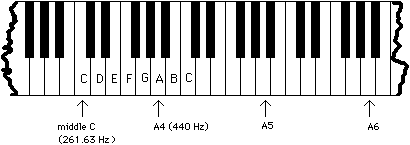MU 207 Midterm Study Guide
Office hours 4:30 - 5:30 pm Tues
MacLaurin A177
Source
materials: CLASS NOTES, TEXT,
VIDEOS
Introduction
to acoustics. Sinusoids, Hooke's law, SHM
Vibrating
spring vs. vibrating string,
![]()
(T = tension in Newtons, µ = mass per unit length)
Amplitude, frequency, period, phase
wavelength: v =
f λ
T = 1/f or f = 1/T (T is the period)
Harmonics,
resonance, standing waves, difference between modes and nodes
Fourier
Theory, Time domain vs. frequency domain
Digital
Audio, Sampling, Information theory: Nyquist/Shannon
Sampling
rate, aliasing
Quantization,
dynamic range ("6 dB per bit"), mp3, perceptual coding vs lossless compression
How
does a computer make music?
The
physics and mathematics of intervals, cents, tuning systems: just, Pythagorean, meantone, equal tempered
pythagorean and syntonic commas
Psychoacoustics
Fletcher-Munson curves
ANIMATION: Auditory Transduction
The Science of Musical Scound (coursepack):
Chapter 3 is about sine waves, harmonics, harmonic series (p 44), resonant modes (standing waves) and Fourier Theory.
Chapter 4 is about tuning systems, and has a slightly different take than the way I presented it, but this chapter describes just intonation
Just intonation is specifically derived in Figure 4-5 on page 70, cents on page 72.
Chapter 5, pages 78-82 are about critical bands
Chapter 6, page 92-95 is about virtual pitch (Jan Schouten)
Chapter 7 is about the anatomy of the auditory system, p 112 discusses critical bands again briefly.
Chapter 8,
page 123 describes Fletcher-Munson equal-loudness curves
MIDI and computer music systems. (Appendix G)
Musique
Concrete, Early Electronic Music
Reference (not necessarily all used or referred to)

• At room temperature (68° Fahrenheit), the velocity of sound in air is: 343 meters/second = 769 mph = 1,128 feet/second = 769 miles/hour.
In water the speed of sound is: 1,497 meters/second.
![]()
![]()
![]()
![]()
![]()
where v is velocity, L is length of the string or air column
![]()
![]()
![]()
where v = velocity of a disturbance passing along a string, T is tension of the string, µ is mass per unit length (thickness)


(if your calculator can't do log base 2)



"6 dB per bit"
1¢ is defined as 1/100th of an equal-tempered semitone
Quarter-comma Meantone temperament:
C D-½δ E-δ F+¼δ G-¼δ A-¾δ B-![]() δ C
δ C